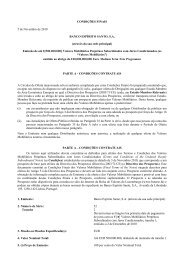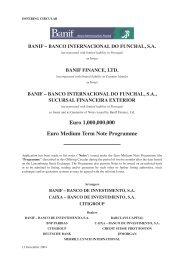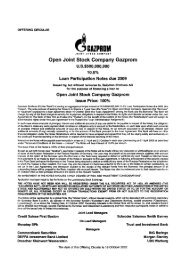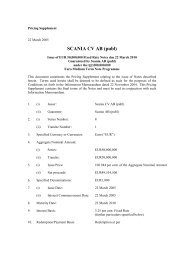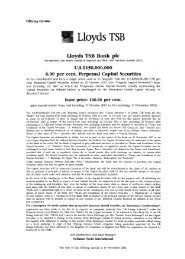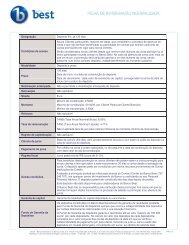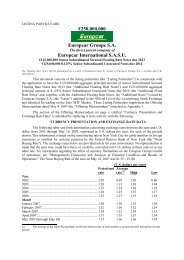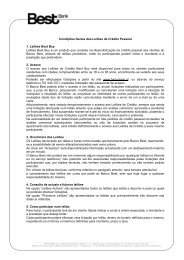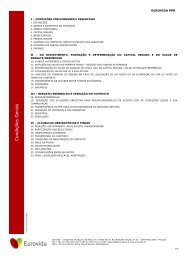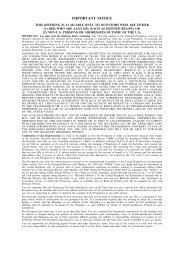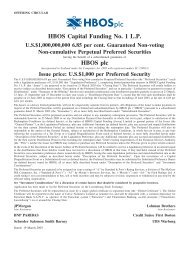Espírito Santo Investment p.l.c. Banco Espírito Santo de ... - BES
Espírito Santo Investment p.l.c. Banco Espírito Santo de ... - BES
Espírito Santo Investment p.l.c. Banco Espírito Santo de ... - BES
You also want an ePaper? Increase the reach of your titles
YUMPU automatically turns print PDFs into web optimized ePapers that Google loves.
espect to the previous year. <strong>BES</strong>I's rating profile and sector distribution reflects its main loan activities with a<br />
remaining focus on project finance, namely in transport infrastructure and energy sectors.<br />
Around 25.5% of the total loan portfolio with internal credit ratings are investment gra<strong>de</strong>. Non-investment gra<strong>de</strong><br />
loans with bb+ and bb ratings accounted for around 41% of the portfolio and inclu<strong>de</strong> mostly highly complex credit<br />
transactions, generally guaranteed by real assets, which are not reflected in the level of ratings assigned, but which<br />
constitute important factors in risk diversification and mitigation, namely in the calculation of expected losses. <strong>BES</strong>I's<br />
guarantees and advances provi<strong>de</strong>d amounted to €411.7 million at the end of 2009. About 63.6% of these guarantees and<br />
advances were investment gra<strong>de</strong>. The main sectors were the financial sector, particularly <strong>BES</strong> and the energy sector,<br />
which together represented 57% of the total guarantees. The industry sectors financed are wi<strong>de</strong>ly diversified, with<br />
particular emphasis on Transport Infrastructure, Energy, Finance, Construction and Real Estate.<br />
Unused credit lines amounted to approximately €201.7 million at the end of 2009, relating mainly to undrawn<br />
funding relating to project finance transactions. These undrawn amounts were mostly in the Energy, Transport,<br />
Infrastructure, Real Estate, Utilities and Others sectors. Overall loans, non-used credit lines, guarantees and advances<br />
were distributed by country as follows: Portugal (38%), Spain (35%), Brazil (9%) and the United States (7%). The<br />
remaining exposure was divi<strong>de</strong>d between entities with their operations in Switzerland, Poland, the United Kingdom and<br />
Canada. This reflects the Bank's internationalisation strategy.<br />
Despite the trend for a global economic recovery, which began in mid-2009 and is expected to continue during<br />
2010 and in spite of the Bank’s slight improvement in overdue loans, which fell 18 basis points on the previous year to<br />
0.53% of total lending, the Bank strengthened its provisions, aware of the possibility of some <strong>de</strong>terioration in its loan<br />
portfolio and in line with the policy of previous years. This had a positive impact on the coverage of overdue loans and<br />
interest by provisions and the cover ratio rose to 430% in 2009 up from 206% in the previous year. The increase in<br />
provisions had a negative impact on the provisioning cost, which rose by about 90 basis points in 2009 to 1.55%.<br />
Interest Rate, Currency and Equity Derivatives<br />
In a progressively more adverse economic environment, credit risk relating to the Bank's portfolio of interest<br />
rate, exchange rate and equity <strong>de</strong>rivatives (calculated in accordance with the rules set out in Bank of Portugal Ruling no.<br />
5/2007, essentially based on the sum of the replacement cost and potential future credit exposure), remained at<br />
approximately the same level as in 2008, totalling €911.9 million in December 2009.<br />
In terms of risk profile, about 60% of <strong>BES</strong>I's risk profile <strong>de</strong>rived from these instruments is with counterparties<br />
with investment gra<strong>de</strong> ratings. Around 51% of the total exposure is to the financial sector, namely to financial<br />
institutions based in Continental Europe, Brazil and the United Kingdom.<br />
Credit Derivatives Portfolio<br />
As a result of the global economic crisis <strong>BES</strong>I substantially reduced its risk relating to its credit <strong>de</strong>rivative<br />
portfolio. Credit <strong>de</strong>rivatives portfolio risk is measured based on the notional value of the un<strong>de</strong>rlying contracts and the<br />
risk of the un<strong>de</strong>rlying reference issuer, when <strong>BES</strong>I is selling protection, and of the counterparty, when <strong>BES</strong>I is buying<br />
protection (from financial institutions). At the end of 2009, the total risk of this portfolio was approximately €41.7<br />
million, representing a reduction of 63% over 2008. In terms of risk profile exposure and sector distribution of this<br />
portfolio, 40% of the ratings were equal or higher than BBB- (investment gra<strong>de</strong>) and exposure was largely to European<br />
companies in the financial or financial groups sectors.<br />
Bonds Portfolio<br />
The bond portfolio totalled €1.546 billion in 2009, an increase of approximately 28.4% over the previous year.<br />
Taking into account the full consolidation of the portfolio of <strong>BES</strong> Investimento do Brazil, which is mainly composed of<br />
Brazilian Treasury Notes and Brazilian Central Bank Notes (issued and fun<strong>de</strong>d in local currency), the risk profile of the<br />
bonds portfolio in 2009 remained virtually the same as in 2008, reflecting the fact that there was no change in the rating<br />
of the Republic of Brazil. At the end of 2009 around 85% of the bond portfolio was comprised of ratings equal or higher<br />
than BBB- (investment gra<strong>de</strong>). About 79% of the bonds portfolio was comprised of securities issued by state/central<br />
administration entities or by financial institutions, with good quality risk and a high level of liquidity.<br />
<strong>BES</strong>I's policy is to hedge the sovereign risk inherent in securities issued by emerging markets (notably Brazil)<br />
through the issuance of Credit Linked Notes, the acquisition of Credit Default Swaps and also through guarantees<br />
provi<strong>de</strong>d by third parties, generally with exposures in Europe and the United States.<br />
18



